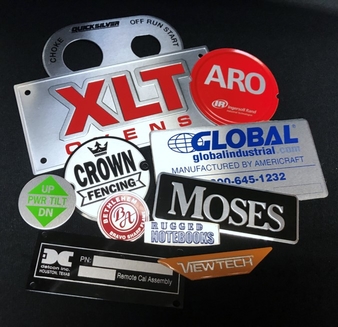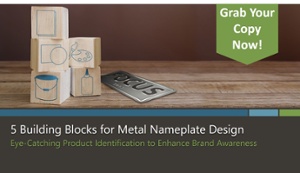Maybe you have a new product to introduce to the market and need a nameplate for it. Or perhaps you are looking for an alternative supplier for an existing label. It makes no difference - there are a few things that you can do to prepare for communicating with your chosen supplier that will keep things moving and set appropriate expectations. Here are five of them.
 1 - What is the Objective of your Nameplate or Label?
1 - What is the Objective of your Nameplate or Label?
A nameplate can take on a variety of roles. What is it that you want your nameplate to do? The purpose of your nameplate or label can help determine the right material and tooling needs. Some options include:
- Brand awareness - the "jewel" or recognizable element on your product that supports your brand strategy and gets you noticed
- Asset tracking - inventory control, record of preventative maintenance, or display variable data with a bar code, QR code, or serialization
- Functional overlay - protective component that displays functional buttons, LED windows, user instructions, and product branding for equipment.
2 - What Environment is the Label Going Into?
The type of environment that your metal nameplate or plastic label will be used in is important to know. Questions to keep in mind include:
- Is there exposure to extreme heat or cold?
- How long does the nameplate or label need to last?
- Is the product designed for indoor or outdoor use?
3 - How will the Nameplate or Label be Attached?
A seemingly simple question is whether or not adhesive is needed for your nameplate. This is basic yes or no, right? To a degree, this is true. If the answer is yes, the next question that will be asked is what is the mating surface? This is the more complex question because different surface types will require different attachment solutions. Questions to keep in mind include:
- What type of surface does the nameplate or label need to stick to?
- Is there exposure to high heat?
- Is there a bend or contour to the area that the nameplate or label will be attached?
It is most common to find nameplates and labels using 3M or other pressure sensitive adhesives for secure attachment. Some surfaces like powder coated metals, low surface energy plastics, textured surfaces, require extra attention. If adhesive is not a good fit, we can explore mechanical attachment with rivets or screws.
4 - Are there any Regulated Marks or Graphics Needed?
Each situation is different. Perhaps your product requires conformance with UL markings or OSHA/ANSI warnings. This is important to call out on your artwork and request for quote so that we make sure that material and processes reviewed are in compliance. UL Marks are registered trademarks under strict guidelines for printing as established by Underwriters Laboratories. McLoone is authorized to print UL registered certification marks. Anytime the UL mark appears on the printed part, we must have approval from UL on file with the customer print.
5 - What is your Timeline?
It is important to understand what lead time is needed to build the quantity of parts for your order. The more complex the process involved in making the nameplates or labels, the more time should be allowed.
How Can We Help?
Now that we have reviewed some tips to get prepared to talk about your nameplate or label project, you should feel confident to take the next step and contact us for discussion. Over 65 years of experience working with companies in every industry means a wealth of inspiration is available to use. Our Customer Care team is ready to work with you!
Related Posts
The Key to Effective Nameplate Design: Communication
3 Things to Expect from Every Nameplate Design Project
How to Keep Your Nameplate Project on Track
3 Factors to Consider When Sourcing a Nameplate Supplier



